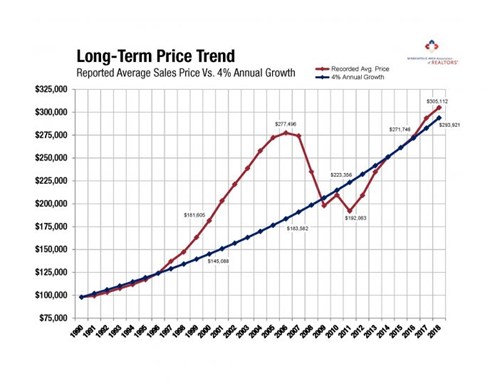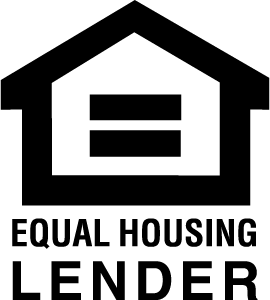
Anyone who watches the evening news or reads the local paper will know that home prices have been on the rise over the last few years. And while the headlines commonly explain that increasing home values can be attributed to low inventory and high buyer demand, there are other factors at play, too.
Whether you’re a homeowner who’s hoping that prices continue to trend upward, or you’re worried about another housing bubble, here are insights you can use to understand the mechanics of home price appreciation — and what today’s market means for you.
Simple supply and demand
If you’ve taken a high school econ class, you may remember the basics of supply and demand — and you can extrapolate that principle to our local housing market. When there are more buyers in the market than homes available for sale, the advantage points to the seller.
For the last few years, that has been the case across Minnesota and western Wisconsin (and much of the rest of the country). But why?
Buyer demand has exceeded seller inventory for many reasons, including:
- A healthy and growing economy, with low unemployment rates
- The entry of the “millennial” generation — which comprises 35 percent of the U.S. labor force — into the housing market
- So-called “boomerang buyers” — the group of homeowners whose homes were foreclosed or sold via short sale during the downturn — have returned to the market
- A slow-moving new construction industry, which has not yet returned to its pre-recession production numbers
- Historically low interest rates, which have increased the buying power of borrowers (and coaxed them into the buyer’s seat)
- Homeowners remaining in their homes for longer between sales
All of these factors have led to an influx of buyers vying for a relatively small number of for-sale existing or new construction homes. And as buyers compete, they drive prices upward; in June, we saw that more than half of homebuyers in our 13-county metro area paid higher than the list price of homes on the market.
In short, homes are in relatively high demand and short supply, therefore most sellers do not have to entertain the idea of offering their home at a discount.
Location and condition
Of course, not all homes are the same, so not all homes appreciate at the same rate. To determine how much a specific house has appreciated against its counterparts down the block or even two suburbs over, you must also take into consideration the property’s location and general condition, as well as hyperlocal market dynamics.
Location
An ideal location can vary depending on the type of home you have, but homes may appreciate more quickly if their location is:
- Near great schools, parks, lakes, biking or hiking paths, pools, community centers, hospitals, clinics and other local amenities and services
- In close proximity to commercial districts boasting cafes, shopping and dining
- A short drive from a main thoroughfare or interstate, which could help shorten a commute
- Close to a public transportation hub
- Adjacent to land that can never be developed, such as nature preserves or cemeteries
Not sure how to tell if your home is in high demand (and subject to recent home price appreciation)? Start paying attention to how long homes in your area are on the market.
If for-sale signs in your neighbors’ yards are changed to read “Sold” in a matter of days, it could be a good indication that your home is in high demand and has appreciated since you last checked its value. To learn what your home may be worth, reach out to a neighborhood expert for a no-pressure home value estimate.
Condition
If you take pride in your landscaping and have kept the home up-to-date (or better yet, renovated it over time), then your home may be appreciating even faster than other homes on your block.
Homes may appreciate faster if:
- They’re well-preserved, with original details like hardwood floors or built-in cabinets
- They’ve been fully updated to reflect the must-have items of current buyers, such as a renovated kitchen or an open floor plan
- The systems (electrical, plumbing, HVAC) have been well-maintained over time
- The exterior has been updated with new siding, a new roof or standout landscaping
The product mix effect
Consider, too, the type of home you’re selling — and how it stands out in today’s marketplace. David Arbit, the director of research and economics for the Minneapolis Area Association of REALTORS® (MAAR), explains that the housing market is too often analyzed as though it’s homogenous, when in reality it’s comprised of an ever-changing array of homes being listed and sold everyday. The result is that there are many highly localized and micro dynamics such as supply and demand, location, schools, proximity to jobs, shopping, water bodies and more affecting home price appreciation in every neighborhood, every day.
“In 2009-2011, at the lowest point in the housing crisis, housing basically went on sale. This was great news for qualified buyers but somewhat frustrating for some sellers. One reason for this was that sellers were more motivated to sell than buyers were to purchase and so they had to price adjust downward and chase buyers to compete with other sellers. Another big reason for this depreciation was that at one point more than 50 percent of homes for sale in the 13-county metro area were distressed home sales — foreclosures or short sales,” explains Arbit.
“Because those distressed homes were being sold at such a discount, and there were so many of them on the market, buyers were very unmotivated to pay top dollar for ‘traditional’ or ‘non-distressed’ homes. What we saw was that the “mix” of homes on the market was creating an unprecedented drop in overall prices, but most of that was attributable to foreclosures and short sales—meaning non-distressed home prices didn’t decline as much.”
During the downturn, then, the product mix of homes on the market was comprised of (and skewed by) distressed sales. Today, a large influx of single-family homes or new construction homes may be impacting the sales numbers in your area. To get a clear perspective of what’s happening with home price appreciation in your neck of the woods, reach out to your Realtor for local insights.
How much is too much? Should we be worried that home prices have been rising for so many years?
While it’s true that home prices have been on the rise for the last seven years, a study of local pricing trends shows that this growth has been pretty steady when measured over a longer period of time — and far from the “spike” in home prices that we often see prior to a housing market bubble.
In fact, a recent trendline created by MAAR shows that the average increase in year-over-year sold prices from 1990-present is about 4-5 percent , which is very close to our current year-over-year price growth trend. During the pre-recession boom, prices were rising much faster than that — at rates up to 10 percent annually.
In short, if you started with the average home price for a 1990 home in the 13-county metro area, and appreciated that home’s value by 4 percent each year until you reached 2018, the final value would be quite close to the average value of today’s local homes.

Graph courtesy of Minneapolis Area Association of Realtors
“We shouldn’t fear steady home price appreciation; over the long-term, home price appreciation has consistently exceeded inflation. By contrast, bubbles occur when prices are rising without the demand there. The reality today is that demand would be even higher if we had more supply of homes for sale. We’ve seen more of a steady upward trend and the market is in much better shape than during 2004-2006,” said Arbit. “To be able to show that today’s real price growth is about 2 percent per year (after factoring in an annual inflation rate of 2 percent) is helpful to understanding that today’s market and economy are rolling along at a steady pace; it’s not the runaway train that we saw in the late 90s and early 2000s.”
Wondering how much your home is worth?
Remember, your house could be worth more than the one next door, so it’s important to receive a market analysis from a local expert. Reach out to Edina Realty’s customer care team seven days a week to get in touch with a specialist who knows your area inside and out.









 ©2025 Prosperity Home Mortgage LLC®. (877) 275-1762. 3060 Williams Drive, Suite 600, Fairfax, VA 22031. All first mortgage products are provided by Prosperity Home Mortgage, LLC®. Not all mortgage products may be available in all areas. Not all borrowers will qualify. NMLS ID #75164 (For licensing information go to: NMLS Consumer Access at
©2025 Prosperity Home Mortgage LLC®. (877) 275-1762. 3060 Williams Drive, Suite 600, Fairfax, VA 22031. All first mortgage products are provided by Prosperity Home Mortgage, LLC®. Not all mortgage products may be available in all areas. Not all borrowers will qualify. NMLS ID #75164 (For licensing information go to: NMLS Consumer Access at